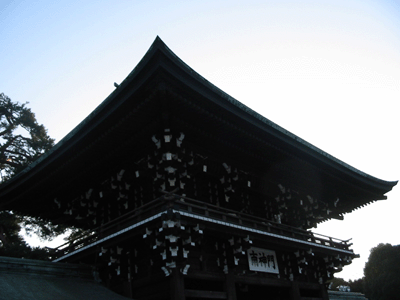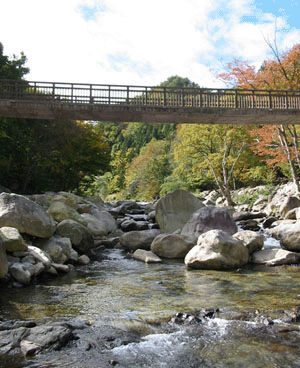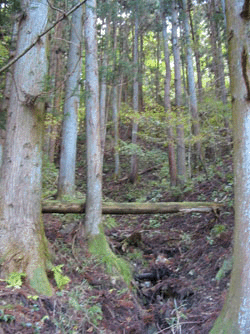
picture: The Meiji Shrine in Tokyo, all decked out for New Years
Here are a few odds and ends, topics that either took me by surprise, that people often ask about, or that I just thought might be fun to share.
Shoes On, Shoes Off: A new method of learning karate:
One of the most confusing traditions that I quickly learned was how to determine what shoes are appropriate to wear in which places. Shoes worn outside are, of course, never worn within the house. But they are also never worn inside the school or in some offices, either. At the front door of a home you exchange you shoes for a pair of slippers. You wear these in the rooms that do not have tatami floors. When you enter a tatami room, you don't wear anything but socks (which, if you're careful, will not have holes in them). When you go to the bathroom, however, you exchange your house slippers for slippers that are just for inside the bathroom. All of this footwork gets a little awkward and confusing after a while. Mortifying events can occur if you lose track of where you are and what should be on your feet -- if you wear slippers onto a tatami floor, you've made a large mistake. If you wear your shoes inside a house, you have again made a mistake. The worst is if you wear the bathroom slippers in the rest of the house. This is tragic. It is basically considered as good as tracking feces all over the house.
So, I live alone in my small apartment ... Do I cheat? Only a little. I take my outside shoes off at the door and usually put on slippers (especially in the winter when the wood floors are like sheets of ice). Like a good tatami-floor-loving person should, I remove my slippers before going into my tatami rooms. My only cheating point is the bathroom slippers... I find it pretty bothersome to change shoes just to use the toilet, so I don't. I figure I keep my bathroom floor clean enough. I do, however, keep a pair of slippers in there, and it always makes me smile to see that they've been worn when a Japanese friend visits my apartment.
Schools and offices seem to have their own policy. At the town hall where I work some people change to inside shoes at their desks when they arrive. "Inside" shoes can be nearly any shoe, often preferably comfortable, that has never, EVER been worn outside. This is the basic policy for inside shoes at school, from trainers to slippers, and I often find myself doing double-takes when I see a nicely suited teacher wearing bright white trainers, or my favorite: a suit with bright socks and tevas.
Because of all this shoe-changing, the entrance to shoe-discriminating buildings always have an area to change your shoes. These are very large rooms at the schools where each student is given a cubby-hole for their shoes, but it can be a very small room like in my apartment (about 2.5 feet by 3 feet) which also has a special set of shelves for extra shoes. Likewise, many restaurants often require you to remove your shoes before entering a tatami area. The nicer restaurants and every community center I've been to all require you to remove your shoes when you enter, and then provide you with cheap, ill fitting, uncomfortable slippers to shuffle around in... And to keep them from falling off, it is necessary to shuffle-walk.
I have also been asked by many young students if Americans sleep with their shoes on. Although Clint Eastwood didn't help with this image while sleeping with his boots on in "A Fistful of Dollars," I try to explain that we don't view our shoes as particularly dirty or floor-damaging. Since it's always seen as gross here, I'm afraid that my explanations don't really do much other than set in the minds of these young students that Americans don't know what dirt is.
The Shower, the Bath, and the Bathroom: A confusing system

One of the things that has taken me quite a while to get used to has been the shower, tub, and toilet system. While in America I was used to these being combined in the same room, here they are all separate and thus a little confusing.
The Shower: sit and scrub
In Japan showers are taken while sitting on a teenytiny stool, about six inches off the ground and scrubbing with one hand while holding the showerhead in the other. Luckily, the room this is performed in is all waterproof, so there is no need to be careful where you aim the showerhead. It does, however, take a little coordination to scrub and squat and direct water accordingly simultaneously. The floor is tiled and has a drain, so the water drains away without any problems, except, of course, if the tiles are chipped like mine and the water doesn't drain, but instead ends up creating an ice patch in the winter. The showerhead also tends to freeze in the winter, indeed, I once had to make a guest of mine wait to take a shower until I'd attacked the shower hose with a space heater for a while and attempted to melt the ice skating facilities (sorry, Drew!).
The Tub: Sit back, relax, and enjoy your bath
Next to the showerhead and stool is a bathtub, which isn't very long, but is deep enough to sit up in with only your head and shoulders coming up out of the water. Wait, let me correct that, it's deep enough for me to sit up in and still have water up to my chin, but I'm not very large by American standards (although I'm extremely large by Japanese standards.. I'm HUGE!). My neighbor with the same sized bathtub cannot fit inside his, and he's of a more standard American size (He, incidentally, is also resourceful: even though he cannot use his bathtub for bathing he stores his empty beer cans in there until it's recycling day... the tub fills up pretty quickly). Now comes the question: Why is the bathtub next to the shower area instead of having them combined like in the U.S.? Well, for a few reasons. One reason is that the Japanese like to clean themselves before slipping in the tub to relax, not clean. In theory (and I'll admit to being a little critical of this) with this bathing system the water stays clean enough for the second reason: they conserve water by using the same bathwater. It is common for an entire family to share the same bathwater in an evening (oh, yes, and bathing happens at night, never in the morning), and I've heard that some families even continue to use the same water for a week. This makes me glad about the fact that I live alone. I've also read that sometimes the water is siphoned from the tub to the washing machine. While it would be great to have warm water to wash my clothes in, I haven't tried this yet, and I'm not so sure I will.
Another interesting element in the whole bathtub arena is that you run cold water into the tub, then you turn on some gas-powered monster-super-duper machine that pushes steam into the water to heat it up. This makes for a very toasty bath (which is greatly appreciated, considering the sheet of ice that builds up on the floor!), but you need to remember to stir the water every now and then while it's heating up, otherwise you will have steamy warm water on the top, and what feels like a block of ice on the bottom. It's not fun. I've made this mistake.
The Japanese-style bath can be a great experience if you do it right, however, and there is a little guilty pleasure in it, too: after years of hearing "don't splash water on the floor!" as a child, I always feel decedent stepping into a full bathtub and hearing the water spill over the edge and draining through the floor.
Toilets: From one extreme to another
Here is something that stumps me: the giant difference between the toilets in Japan. There are two kinds: The eastern style toilet and the western style toilet. The eastern style toilet is common for public toilets: it's at the town hall I work in, in all the schools I teach at, in the community centers I've been to, and at many bars, restaurants, and shopping centers. Although it's not exactly a hole in the ground, the assumed position is the same: it's basically a squatter toilet. Maybe it was because I didn't participate in Girl Scouts for much of my life, or maybe just because I'm just a wimp, but it took me about three weeks to work up the courage to use one of these. You squat, you go, you flush. Enough said, right? It's not as bad as I'd originally anticipated, and there are a few up sides: One is that it's much, much more sanitary than western style toilets since your body doesn't come into contact with anything. The other I learned at a hospital for some routine tests and was given a cup for a urine specimen... it was a lot easier to collect.
The other toilet is the western toilet. But it's not just any western toilet, no, most western toilets in Japan are the super-deluxe model. Ranging from basic with only a heated seat to super-duper with warm water sprays, running-water sounds, and sensors that will trigger running water when you sit down, and, well, honestly, more buttons than I have had the courage to push. These are usually found in private homes, and I am a proud owner (or renter, or whatever) of a heated-seat model. When I first used a heated seat toilet I was on the Shinkansen (or bullet train) and thought to myself Man, this is really warm, someone must have been on here for a long time. I later realized that this is normal for western style toilets, and if you know how to work the buttons correctly, you can even change the temperature! I didn't realize that there was any problem with a heated toilet seat until I was visiting a friend in Sendai who has a normal (cold) western toilet. It was a chilly day... My body was shocked by how cold the seat was that I nearly couldn't go.
Another interesting thing about western style toilets in Japan is that they try to conserve water. The water tank has a built-in sink and faucet that runs water when you flush. Don't worry, though, the water is the clean water that is refilling the tank. You are meant to rinse your hands in this (no soap). Another method of conservation involves the flushing itself. Often the handle will have two kanji on it. One that means 'big' and the other that means 'small.' If you pull the handle one way, you get a big flush, and if pull it the other way, you get a small flush, depending on what you need.
The toilet, the shower, and the generation gap.
I have learned from some of my Japanese friends that some of the elderly Japanese either become a little confused about how to use western toilets and showers, or find them too strange for comfort, and often end up misusing them. In order to save room, many hotels in Japan have a shower/tub combination like the U.S. bathtubs. Unfortunately, as most Japanese have been showering outside of the bathtub their entire lives, they don't understand (or enjoy, I'm not sure which) showering inside the tub. Hotels have complained about this greatly because many older folks have taken the showerhead out of the tub area and attempted to shower outside the tub, only in a room that is not waterproof and with a floor that doesn't drain, and they end up damaging the bathroom.
Another habit that some of the elderly have begun involves the invasion of the western style toilet into their homes. Accustomed to squatting, many older folks will raise the nicely warmed seat, and, facing the water tank, will squat over it -- or maybe they climb onto it, I'm not really sure how they do it -- but I've heard that they do. I suppose this explains the raised seat at my temporary host family's house when only Granny and I had been there all day.

Wanko Soba
While at orientation with other ALTs we all were invited to partake in an experience unique only to Morioka City (the largest city in the Iwate prefecture). Soba itself is a type of Japanese noodle made from buckwheat flour. Wanko soba, however, is the tradition of eating this from small bowls that have the supposed equivalent of a mouthful in them, then stacking up the bowls to see how many you could eat. Once you hit a hundred (think: A hundred mouthfuls of noodle, any noodle -- oh my!) you get a special certificate. The most humorous part of this whole experience is probably the fact that the soba is served to you at a rapid rate, mouthful after mouthful sloshed into your bowl by a woman who says "Hai, doozo" (translation: 'Here you go') in a high pitched voice while droping the just-emptied bowl loudly onto the growing stack in front of you.
By the end of the meal you have a stomach ache, your can't see the people you were dining with because you view is blocked by stacks of bowls, and you don't want to see soba again, EVER. But there is this women still sloshing noodles in front of you, staring at you until you eat them, then racing you to refill your bowl -- either you must cover your bowl with a lid, or she will slosh more noodles in front of you and expect you to down them again before skillfully refilling your bowl. There isn't a lot in Morioka, so I suppose that this is one of the things you must do while you're there -- but it's probably something you only want to do once. At the time I'm writing this it's been four months since my soba stomachache, and I am only beginning to warm up to the idea of soba again.
(I felt like I was going to explode around bowl number 57, kept losing the bowl-covering race for another 5 bowls, so my total was around 62. Now, apparently, most women average around 20 to 30. I told you! Here in Japan I am HUGE!)

Heating and Cooling
I grew up with central heating and heavy air conditioning. To me this seemed like a given - it gets hot and cold outside, so you want to keep your house warm and cozy or cool and soothing all the time, right? Well, right for the U.S. maybe. But for Japan? Wrong. The Japanese believe that one should adjust to the outside temperatures by warming the body, or the immediate area, rather than an entire building. This is the reason for my single-room kerosene heater, kotatsu, and newfound love of sweaters and soup. In the summer it's the same story ? use a fan, open the windows (which are usually also doors and if you're lucky, they'll have screens to keep out the hoards of dragon flies), and drink lots of cold green tea. But what about schools? Surely they are more concerned for keeping the students warm enough or cool enough, right? Well, they're concerned, but they don't heat the entire building. Instead they heat each room with kerosene heaters, and the process of walking from classroom to classroom is simple enough: you freeze. Since I am a visiting teacher, I tend to get the "extra" desk, the one placed away from the heaters and away from the windows, but by the cold and draughty door. Let's just say the cool breeze keeps me awake.
Another thing that I found frustrating and a little unusual when I first arrived here is the Japanese attitude towards sun exposure. My first month here I was asked to attend the sports day gathering for all the students in the area. Once I got there I was asked to help out, measuring the high jump bar for elementary school kids. This was all fine, except it was a very hot day, the sun beating down on me as I became more and more thirsty, but didn't feel polite sucking down a dozen half-filled cups of cold tea. Now, I am an extremely pale person. When I stand in the sun for five minutes I begin to resemble a boiled lobster. Fair skin is admired by the Japanese (much as being tan is usually the fashion in the U.S... or at least in Alabama), and many women strive for paler skin by using "whitening creams" and shading themselves from the sun with an umbrella. Fair skin like my Irish/Scottish/English/German/Polish type, however, is not common and thus the concept of SUNBURN is not completely understood. At this sports day event I had no sheltering umbrella, had no sun block, and had no way of politely telling my supervisor that I needed to sit in the shade. By the end of the day I was nearly purple and everyone was surprised. Surprise and embarrassment are often expressed by laughter in Japan, and I was miserable for many weeks - while resembling many food types: at first a plum, then a cherry, a cranberry, a lobster, and eventually, by October, just a pink mess of sunburn.
Bow-wow-wow
I hate stereotypes. I hate the stereotypes people in the U.S. believe about the Japanese. I hate the stereotypes that the Japanese believe about Americans. I am doing my best to teach my friends here that not all Americans eat Kentucky Fried Chicken, not all Americans have big cars, and not all Americans are incapable of using chopsticks. At the same time I would like to explain that not all Japanese eat sushi, not all Japanese drive small cars, and not all Japanese are incapable of using a fork and knife. There is one stereotype, however, that holds some truth: The Japanese bow to one another all the time. ALL THE TIME. This has taken me some getting used to. Introductions, daily greetings and good-byes, at the beginning and end of a meeting, in the car while passing someone on a narrow road or giving them right of way, at the beginning and end of each period at school, and even - oh yes - on the phone. This is not the elaborate 90 degree bow that you might see in movies, but it's not the simple nod of the head either. It's more of a 40 degree tilt, held long enough to be seen. Sometimes, however, person A will bow, person B will bow back and still be bowing when person A comes up, thus person A sees person B bowing and feels obligated to bow again, and so on and so forth until both are bobbing up and down and I, the observer, think it's both odd and hilarious (and with all that person A and person B stuff I sometimes start to have painful memories of middle school math)
I had one extremely embarrassing incident when, at the beginning of a class, a particularly feisty student caught my eye, then bowed in an odd way, keeping her head up and only moving her shoulders quickly. I soon realized that she'd been making fun of me, of the way I was bowing. Oops! I'm very careful about bowing now, although it still feels awkward and I sometimes forget when it is necessary.
Where to next?
Home
The Japan All Around Me
About me
The Job
Winter: Homesickness